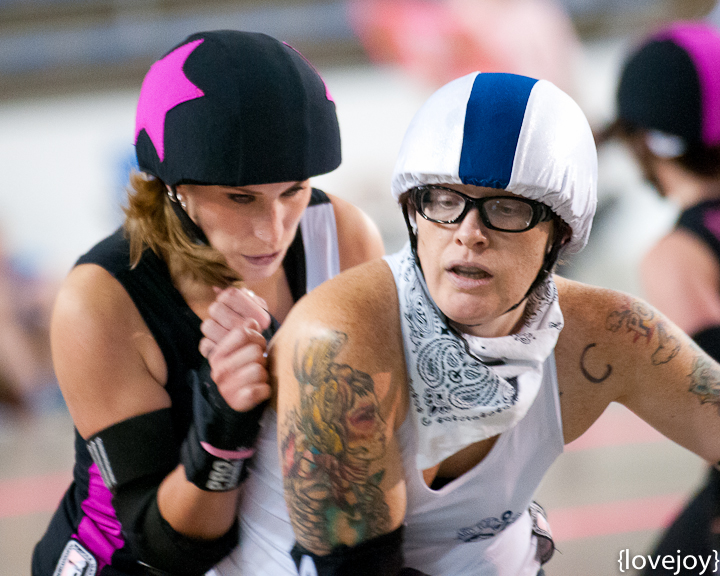When I learned blocking skills (way back when dinosaurs were alive) I learned this: shoulder blocking = shoulder smashes shoulder and hip blocking = hip smashes hip. Sure, I understand the legal target zones and what parts of my body I could use to block with, but the endless possibilities of blocking combinations didn't register. Shoulder to shoulder. Hip to hip. We all did it that way.
Well, we did it that way until we learned about the sternum block. And by "learned" I mean "our opponents were quite effective at teaching us the value of blocking to the front of the torso." Also, many of our skaters developed shoulder problems, I think from ramming their shoulder into another shoulder. And, as the game evolved and skaters learned more skills (spinning, leaping, and avoiding blocks), we found that shoulder-to-shoulder blocking was, well, pretty much ineffective.
You might be thinking something like there are still instances when a shoulder-to-shoulder block is effective. I've seen it!
Well, yes, so have I, but from what I've found those instances are when you are blocking a skater who 1) is just learning to block, 2) doesn't have a good sense of balance, or 3) is already off balance and near falling. And in those cases, any block would take down the skater. In fact, you could probably blow on her and she'll go down.
I don't see much reason to defend shoulder-to-shoulder blocking, because I view it as useless and sometimes dangerous to a skater's health (because of all the shoulder problems). I came to that opinion after analyzing why shoulder-to-shoulder blocking is used and how it could be replaced. I've come up with four reasons that I hope will be helpful to you!
1. Skaters are taught that way and it becomes a bad habit. I'm not trashing on coaches. I think this happens because we have a lot of coaches who are new to the sport. Some coaches teach fresh meat skaters how pass an assessment, rather than how to block and play derby effectively. Take the time and give skaters the best training you can!
2. Skaters aren't fully seeing and taking advantage of all the target zones. When skaters are taught to block shoulder-to-shoulder, they are subconsciously registering the side of the torso as the best target. Correct me if I'm wrong, but I'm pretty sure you'll do more damage when you block to the front of the torso. At least I've received and delivered the most effective blocks to the chest, stomach, and crotch. Instead of shoulder to shoulder, aim your shoulder block into the chest (aiming for the belly button to allow more room for error). Instead of hip to hip, aim your hips into the crotch or stomach. Learn how to block with your ass and your back - they are amazingly effective!
And don't be a one-hit wonder! Try blocking combos: hip to crotch, then a few shoulder to chest blocks, then back to hip blocks, or ass to stomach, then shoulder to chest, then chest to chest, then hip to crotch.
3. The shoulder-to-shoulder block is sometimes the last ditch effort to make contact, kind of like when a skater throws an elbow out, just trying to make some kind of contact with the skater sprinting around them. Sure, you're not always going to be aware and there are times when you'll scramble to play defense, but if you can get under your opponent and throw on the breaks, you'll have much more control, like in these photos.
4. If a skater isn't agile and in control enough to positionally block an opponent, they resort to obvious, committed blocks, usually the shoulder-to-shoulder block. I've been coaching a lot of skaters about committed vs non-committed blocking. In short, committed blocks are the ones in which a skater fully commits to a block in a way that momentarily takes them out of play (they fall down or fly off the track). A non-committed block is a controlled block in which you can easily transition into another position. Positional blocking is non-committal, and can be improved by developing agility, lateral movement, speed control, and balance. You want to catch your opponent by sitting on them, then slowing them down with a forceful quick stop, and then throwing in a block before you come to a complete stop. You need the agility, lateral movement, and speed control to keep them trapped and not moving forward.
The most important thing I hope you take away is this: don't waste your time with shoulder-to-shoulder blocks. They're dumb. Seriously, though, there are so many ways to effectively block. Experiment with that. Recognize when your skills are out-dated or ineffective and start the process of de- and re-programming. Or just build on the skills you have.




Shoulder-to-Shoulder Blocking is Useless